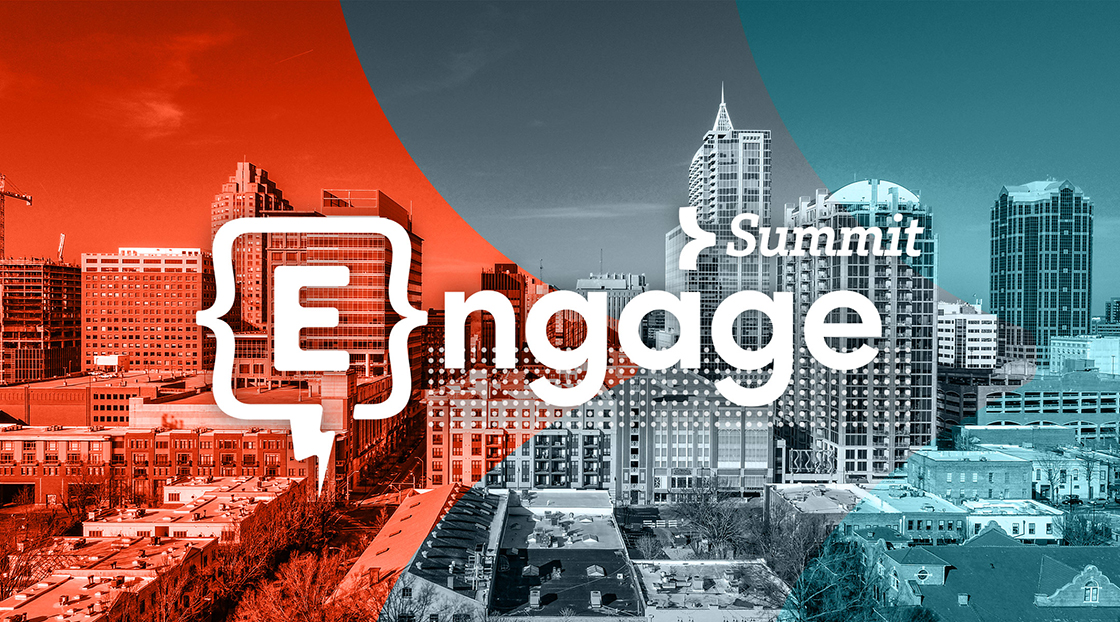Volt recently attended Element451’s Engage Summit in Raleigh, North Carolina. Element451 provides a cloud-based suite of customer relationship management (CRM) applications, such as managing admissions marketing and enrollment routines, for higher education facilities. With artificial intelligence infiltrating every aspect of our lives, it is not surprising that AI would be the belle of the ball at a technology company’s conference. The summit’s speakers and presenters took the conversation beyond “AI is here” to “how to use AI as a tool.”
Engage Summit Recapped: Using AI, Not Just Talking About It
The second annual Engage Summit focused on specific ways to implement AI tools into higher ed marketing processes.

1. AI Is an Opportunity
J.C. Bonilla believes that the current form of artificial intelligence can be likened to pushing buttons on an elevator. Bonilla, who is a professor of analytics at New York University and the global chief analytics officer for VaynerX, noted that for nearly 100 years elevators were moved between floors by a person controlling levers and switches. It wasn’t until the advent of the push button that elevators could be recalled to a certain floor directly by the passenger.
Bonilla said that AI is at the button stage of development: some of the clumsy operating (i.e., sifting through elements that do not pertain to them) is falling by the wayside, and we can now direct people to the floor they need (i.e., the relevant information). To that end, Bonilla indicated that AI can be used in three separate areas of higher education to help streamline enrollment management. Although ChatGPT took the world by storm, there are a host of generative and non-generative AI platforms that can be used throughout the enrollment process.
- Planning tools. For events, surveys and checklists Bonilla encouraged the use of Taskade. With a host of mind-mapping and management tools, this AI tool can take the guesswork out of planning events and to-do lists so that the team can focus on the important aspects of bringing an event to fruition. Think of this as a program to remove the inevitable hours of planning meetings before the real work begins.
- Communications and analytics. For contextual copy and attention scoring, Bonilla indicated that there are numerous options. Although many higher ed marketers are interested in how ChatGPT and generative AI can provide social media posts, many are unaware that neurons can determine exactly where users’ eyes are landing on that post. With attention scoring, the company uses eye-tracking technology to see what elements of a post are being viewed the most frequently and for the longest period.
- Operations. Although human involvement is vital to higher ed enrollment, technology could simplify other daily tasks. Bonilla and his team honed a ChatGPT chatbot over many months to summarize student essays based on predetermined admissions criteria. This task takes admissions teams weeks, if not months, to complete. During the Engage Summit, Bonilla showed how ChatGPT could summarize a lengthy student admission essay in the time it took for him to explain what he was doing.
Although removing the human element from the admissions process is not currently in practice, Bonilla provided examples of how AI could streamline other functions, such as financial aid reports and deposit forecasting. By utilizing AI, the user does not have to think like an accountant to find the answers in a stack of spreadsheets and extensive amounts of data.
Bonilla made it clear that, while there are many potential ethical implications of AI, the technology is not here to take your job, rather “it is an opportunity” to make work more efficient.
2. See the Individual
Whether discussing customers or employees, it is in a company’s best interest to see each individual and use the three Rs: relationship, responsiveness and removal of friction.
- According to Stan Phelps, the author of the Goldfish Series and Forbes contributor, 76% of people expect an organization to understand an individual’s needs. Building this relationship between the individual’s expectations and the company’s policies can lead to brand trust and maximize productivity.
- Unsurprisingly in the digital age, Phelps noted that approximately 81% of consumers demand improved response time. Once the company has developed the expectation of a relationship, it must follow through promptly. With the advent of new technologies, such as generative AI searches and chatbots, higher ed leaders can drastically improve efficiency and response time for potential and current students.
- Consumers want you to remove friction. Whether an institution can do so, 68% of the potential audience anticipates that it will harmonize consumer experiences across channels.
As technology expands and the potential data pool grows, institutions should leverage those resources to make an individualized experience. But, it is important to remember, as Phelps said, “You either exceed or fall short of expectations, you never meet them.”
3. Make Fans, Not Customers
According to the team at Siena College, more than 80% of people now distrust advertising. Moreover, attention spans are shrinking at a phenomenal rate. The average millennial has a 12-second attention span for advertising, but Gen Z is even shorter at 8 seconds. So how do marketers move beyond this inherent distrust and fleeting attention to reach the target audience?
“Customer experience is how we market better,” said Allison Turcio, Siena’s assistant VP for enrollment and marketing.
Siena College’s research indicates that 86% of the population is willing to pay more for a great experience, instead of just a product. Luckily, college and higher ed can easily be considered an experience. It is the experience of knowledge, growth, individuality and opportunity. Higher education has a unique position to turn “customers” into fans by showing the inherent value of the college experience, above and beyond the product (i.e., the degree).
Bonus: How to Plan a Successful Conference
The word “conference” elicits a particular picture: large rooms, cold coffee, chairs in a row, more people than you could ever hope to meet moving from one room to another as if back in school and, in the distant corner, someone’s cell phone is buzzing. Inevitably, it feels like the organizers are doing too much in too short a time. Element451’s Engage Summit had us rethinking the traditional conference model.
- Bigger isn’t better. With limited in-person attendance and a potentially infinite number of virtual attendees, the Raleigh conference was a new take on the hybrid model. With only two adjoining meeting rooms—each with its own specified focus (i.e., industry or product)—attendees were able to move between either session easily. Moreover, every keynote was held in the largest room, and either preceded or followed a meal when the entire group was already gathered.
- If you feed them, they will stay. You heard that right. Element451 provided breakfast and lunch for every day of the conference. No need to scramble to find a local eatery within a designated time block or forego a long-awaited learning session to scarf down food. The food was catered by local vendors, and for those with allergies or dietary restrictions, the company made sure to note which items were safe.
- Showcase the location. Raleigh may be Element451’s home base, but it was also the perfect choice for a mid-summer conference. With relatively temperate weather and a low crime rate, attendees could walk between the hotel and venue and see the downtown. This exposure helped people feel more connected to the host city and invigorated them to sit in sessions.
In addition, because of the limited in-person attendance, the organizers were able to utilize local hotspots for after-hours networking. From a retro arcade to a dueling piano bar, every attendee could find at least one social atmosphere that catered to their personality and comfort level.
- Finally, personalization matters. When was the last time you attended a conference and every member of the organizing team knew your face and your name? Unless you were one of the 200 at the Engage Summit, I’m going to guess never. Team members mingled easily among the attendees during sessions, meals and networking events, as well as in the hotel lobby. Over four days, Element451 was actually able to deliver the one thing that marketers shout about every day: personalization.
Newsletter Sign up!
Stay current in digital strategy, brand amplification, design thinking and more.
Recent in Education Administration
Also in Education Administration

DOE Secretary Linda McMahon already imposed mass layoffs. What’s next?
Before following President Trump’s direction to ‘put herself out of a job,’ the former wrestling matriarch has other ideas and wants Congress to give her a hand.

Higher ed faces a crossroads over Trump’s executive orders on DEI.
Legal experts and educators debate the future of diversity initiatives in the wake of new federal directives.

Higher ed administration gets AI boost.
Working through legitimate concerns, higher ed leaders are finding dynamic ways to integrate AI technology across campus offices.





